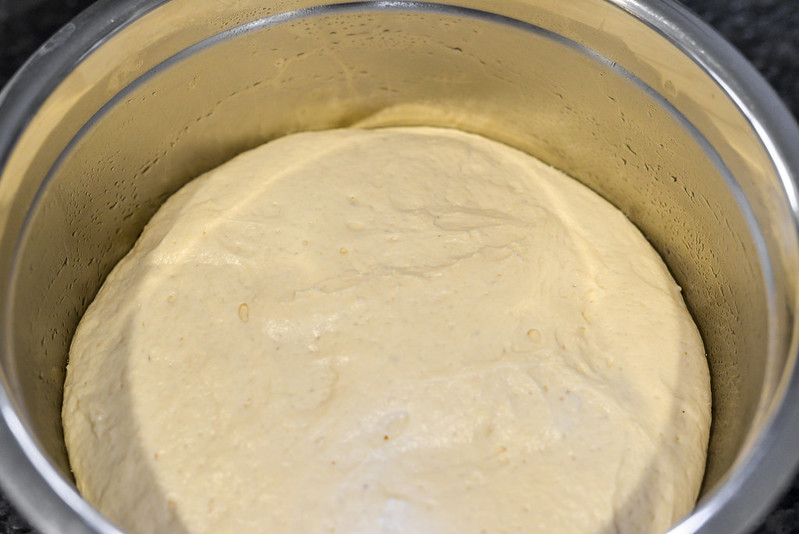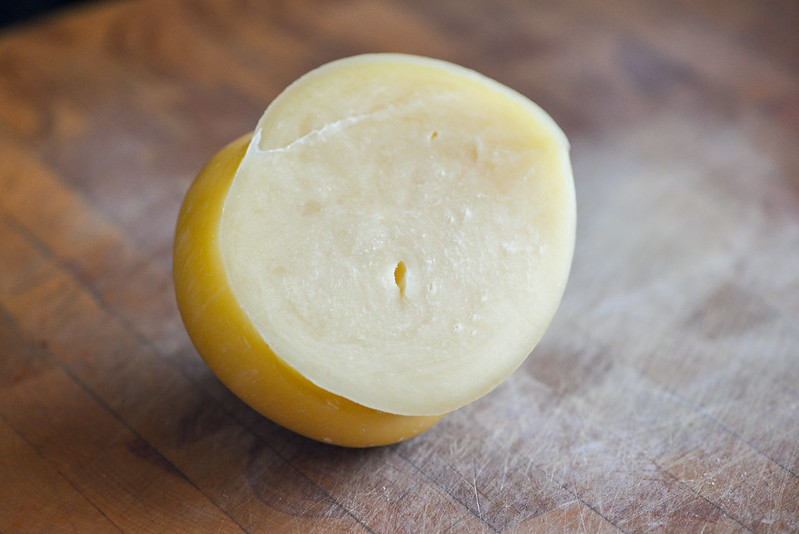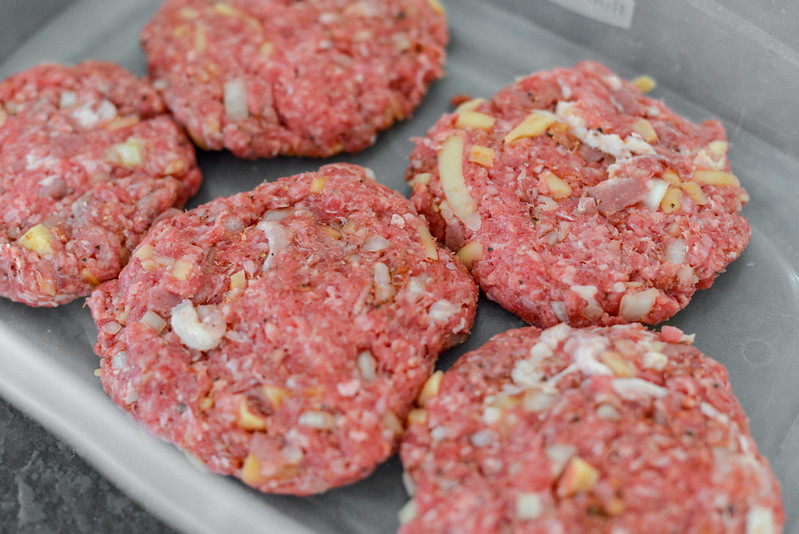Pljeskavica
I have a long history of burger creations that have come out of the Meatwave, so many that I didn't think I'd really be surprised by a burger I made myself anymore. So it was a little floored after I made these pljeskavica—Serbian-style burgers—and was blown away with how they tasted. It was like no burger I've had before, and maybe that unexpected quality heightened my personal love for them, but seriously, they were crazy delicious and think you'd be equally impressed if you tried them too.
Not having had pljeskavica before, I'm not sure how authentic what I created was—I tend to find out after posting that, what I learn about dishes on the internet is often not very true to their origin. One thing I can say though was the lepinja I made to use as the buns was legit. I've had this Serbian flatbread before and successfully made it at home once in the past, and representing one of my earliest baking successes, it's found a soft spot in my heart. The two things to things to really know about this bread is that it's made from a very wet dough and it needs to rise multiple times.
These two traits, combined with a high heat bake, result in a bread with an impressive hole structure that has a slightly crisp outside, and a soft and spongy interior. Usually the loaves are much larger than what you see here, but I purposefully made the lepinja smaller to be burger-sized for this particular application.
For the burger toppings, I knew I wanted three things—sliced onions, avjar, and urnebes. Onions were easy, avjar is a roasted red pepper and eggplant spread I knew how to make already (although I did buy it in the store this time around), so that left urnebes as the new recipe challenge for me. An authentic version of this cheese and hot pepper spread looked it was going to require ingredients that would be difficult to find, specifically procuring the right cheese. So I took some clues from others for a substitute and used a mixture of cream cheese and feta as the base, to which I mixed roasted hot red peppers to taste, garlic, and paprika.
Moving on to the burger portion of the recipe, I found a lot of variations pljeskavica that used different combinations of meats, sometimes included bacon, some with cheese, others without, etc. So settling on one directions wasn't easy, but it also seemed like there was no one right answer and creativity can come into play here. I was intrigued by use of cheese, which can be stuffed in the center or mixed in with the meat. The cheese of choice is kashkaval, which i couldn't find and ended up using its Italian ancestor, caciocavallo. If you can't find that, a mild provolone will suit you well.
Also in the beef mixture was bacon, onion, hot paprika, salt, pepper, and baking soda. That last ingredient may be a bit of a head scratcher, but I was familiar with its use from when I tried out a recipe for cevapi, a Balkan sausage. The addition of baking soda gives the meat a final springy texture that's definitely unique and sets it apart from other ground meat recipes you may have tried.
Another thing I noticed when doing research for this recipe is that pljeskavica can come in a variety of sizes. A flat, oversized patty is fairly common, so is smaller portions, which is what I wanted to do here for serving in large group setting. I did shape my patties flatter than usual to to try get a skinnier end burger.
But that didn't end up doing much as the meat ceased up and cooked into its usual burger shape on the grill. I grilled these over direct heat, flipping them often for even cooking and better browning. I also cooked them longer than I usually do—my preference is for a medium-rare burger, but I let these cook until just cooked through.
Once the burgers were done, I quickly toasted the lepinja on the grill, cut side down, until warmed through. I then slathered a layer of ajvar on each bun and topped with a patty, urnebes, and onion slices.
I was kind of just expecting a slightly more seasoned burger, but the flavor ended up really blowing me away. The bacon added a nice smokiness, not to mention the extra juiciness of its fat, while the paprika went a long way in giving the patty a good touch of heat that was contrasted by creamy pockets of cheese. The meat itself was much different than an American burger, with a finer texture and a springiness that resulted from the use of baking soda. As if that weren't enough, the bread and toppings elevated this from amazing to totally killer. The ajvar had a great creaminess and sweetness that was contrasted by the spicy and salty urnebes and sharp and crunchy onions. The fresh lepinja was also key—if you were to switch to a normal squishy American-style bun, you would be missing a big chunk of the overall experience. This burger really tasted like nothing I've had before, all in very good ways that surprised me, which can be a little hard to do now that I'm 16 years into the Meatwave!
You Might Also Like
Comments
-
Phil The urnebes sound suspiciously like pimento cheese - were the flavors similar?
-
Josh @Phil No, it was not like pimento cheese. It was much more like Greek tyrokafteri, but not sure if you've ever had that. The urnebes was thick and not very creamy. The flavor was salty and spicy.
-
Ivan Sretenovic Alright first I want to salute you on your effort to recreate quite complicated full meal. Lets see, it appears you like hot so here is authentic recipe for Urnebes Salad from south of Serbia where it originates:
Feta Cheese [100%] - 500g
Sweet Paprika [1%] - 5g
Hot Crashed Pepper [1.75%] - 10g
Garlic [2%] - 10g
Hot Ajvar [18%] - 90g
Sour Cream [20%] - 100g
Now as you can see I gave you measurements in percentage where cheese is always 100%, and sour cream is 20% of the amount of cheese you use in our case where you use 500g of cheese that's 100g of sour cream. This way you will be able to recreate exactly same taste no matter how much cheese you have there will be no guessing game. You can also see I gave you Ajvar for this recipe. Its because urnebes traditionally has roasted red pepper too but since it is pain in the ass to roast and peal it you can use ajvar which is 90% roasted pepper anyway. If you never saw this before it is called bakers percentage recipe and used in professional cooking. That's why dishes at some restaurant always taste the same they never change like when you make something at home. -
Ivan Sretenovic Pljeskavica meat is a story for it self. Real pljeskavica is good quality meat of forth quarter of cow. It is mix of different cuts like, neck, chuck, brisket all forth quarter cuts and then you add suet which is kidney fat that is very mild. Reason why you are adding this fat is that you want to create 30% fat in pljeskavica meat mixture. Pljeskavica CAN NOT be low on fat. That's why it doesn't fall apart but rather stretches like rubber.
Now once you got all your meat and suet you cut it on cubes and add 2% of salt per meat weight. For instance for 1000g of meat you are salting it with 20g of salt. YOU DO NOT add anything else. There are no spices, no pepper nothing just salt.
Now you grind this meat on 10mm and leave it 24h in fridge on temperature between 0C-3C. After 24h you take this grounded meat and ground it again on 8mm and then mix it with your hands for like good 20 min.
You are returning it back to fridge again for a few hours to allow proteins to reconnect.
After that you are ready to make pljeskavica. Each one weights ether 120g or 200g. now comes onion. YOU DO NOT mix meat with onion you stretch your patty and put onion on top then fold it back again so onion is in the middle. You don't want onion to burn on grill but to be in the middle to just heat up.
Cooking:
You shape your patty right from the fridge you want meat to be cold when you start grilling. So you make your patty, put onion in it and fold it and place it on hot grill. YOU DO NOT turn. Leave it fro 3 min one side and then 3 min other side.
If you follow those steps chances are you will experience better pljeskavica then you had in serbia since not all places make it proper way. You DO NOT want to put ajvar on it or anything other then: urnebes, onion or cabbage salad. All other condiments will spoil taste of meat which is out of the heaven.
If you wish so I can send you some links for videos so you can see how its made and what's main difference between burger and pljeskavica. Just bare in mind in pljeskavica there are no spices other then 2% of salt per meat weight and onion. Absolutely nothing else. -
Ivan Sorry I forgot very important ingredient for urnebes that you are not using which is 25% of oil. Sunflower for instance or canola don't use olive oil. So for 500g of cheese 25% of oil would be 125g.












